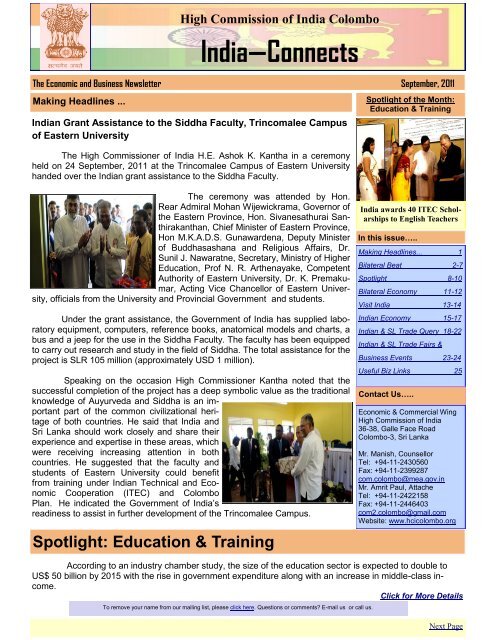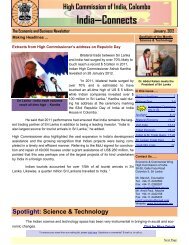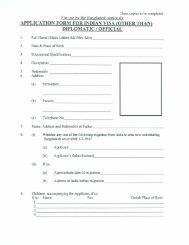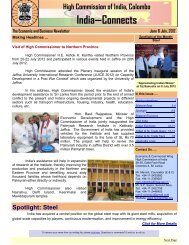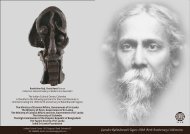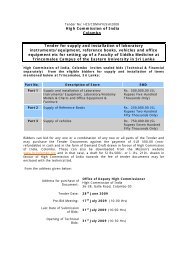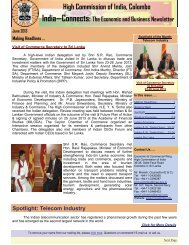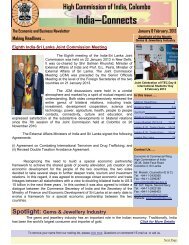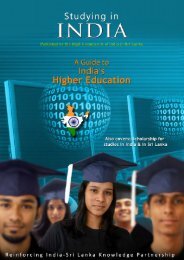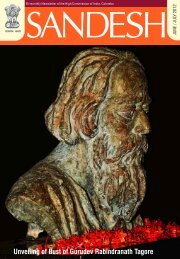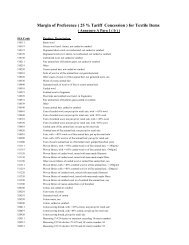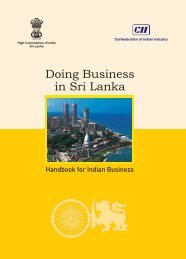IndiaâConnects - High Commission of India, Colombo
IndiaâConnects - High Commission of India, Colombo
IndiaâConnects - High Commission of India, Colombo
You also want an ePaper? Increase the reach of your titles
YUMPU automatically turns print PDFs into web optimized ePapers that Google loves.
BILATERAL BEATSigning <strong>of</strong> the Memorandum <strong>of</strong> the Understanding (MoU) betweenthe Government <strong>of</strong> <strong>India</strong> and the Government <strong>of</strong> Sri Lanka and Awarding <strong>of</strong> the 42ITEC Scholarships to the Teachers <strong>of</strong> EnglishA Memorandum <strong>of</strong> Understanding (MoU) was signed on 13th September, 2011 in <strong>Colombo</strong> betweenthe Government <strong>of</strong> the Republic <strong>of</strong> <strong>India</strong> and the Government <strong>of</strong> the Democratic Socialist Republic<strong>of</strong> Sri Lanka for Setting Up <strong>of</strong> a Three-Tier English Language Training System in Sri Lanka. The MOUwas signed by Hon. Bandula Gunawardhana, Minister <strong>of</strong> Education, on behalf <strong>of</strong> Government <strong>of</strong> Sri Lankaand H.E. Mr. Ashok K. Kantha, <strong>High</strong> <strong>Commission</strong>er <strong>of</strong> <strong>India</strong> on behalf <strong>of</strong> Government <strong>of</strong> <strong>India</strong>. The signingceremony was attended by Mr. Sunimal Fernando, Advisor to H.E. the President and Convenor, PresidentialTask Force on English & IT, Mr. H. M. Gunasekera, Secretary, Ministry <strong>of</strong> Education, <strong>of</strong>ficials from SriLankan Ministries <strong>of</strong> External Affairs and Education and large number <strong>of</strong> teachers, <strong>of</strong>ficial from all the nineProvinces <strong>of</strong> Sri Lanka. Faculty members from the English and Foreign Languages University (EFLU),Hyderabad were also present.The MoU will implement the project entitled “<strong>India</strong>-Sri Lanka Project for Expanding English LanguageTraining in Sri Lanka”. The Government <strong>of</strong> <strong>India</strong> shall utilize the services <strong>of</strong> EFLU, Hyderabad asthe technical consultant for this Project. As part <strong>of</strong> the technical assistance under the MOU, the Government<strong>of</strong> <strong>India</strong> will provide training to 42 Sri Lankan teachers at EFLU under the ITEC programme; provideappropriate equipment and teaching aids for setting up a language laboratory <strong>of</strong> 30 units in each <strong>of</strong> thenine Provincial Sri Lanka <strong>India</strong> Centres for English Language Training (PSLICELTs) and depute expertsfrom EFLU to assist the PSLICELTs. The training <strong>of</strong> 42 Sri Lankan teachers have already begun atEFLU from 19 September, 2011.The technical assistance for English language training programme is being implemented byGovernment <strong>of</strong> <strong>India</strong> as part <strong>of</strong> the initiative <strong>of</strong> the H.E. the President <strong>of</strong> Sri Lanka to develop “English as aLife Skill”. In March 2010, Sri Lanka- <strong>India</strong> Centre for English Language Training (SLICELT) was set up inPeradeniya with the assistance <strong>of</strong> the Government <strong>of</strong> <strong>India</strong>. A digital language laboratory was set up atSLICELT, Peradeniya and training to 80 Sri Lankan English Teachers were provided at EFLU, Hyderabad.<strong>High</strong> <strong>Commission</strong>er <strong>of</strong> <strong>India</strong> in his address said that the MoU signed will further expand cooperationbetween <strong>India</strong> and Sri Lanka in English language training. <strong>High</strong> <strong>Commission</strong>ernoted that <strong>India</strong> was honoured and privileged to be a part <strong>of</strong> the importantinitiative <strong>of</strong> the H.E. the President <strong>of</strong> Sri Lanka. <strong>India</strong> and Sri Lankaare close neigbhours and are uniquely placed to learn from each other experienceas partners in development. He added that EFLU, Hyderabad isa leading institution <strong>of</strong> its kind and a centre <strong>of</strong> excellence to teach Englishto non- native speakers. <strong>High</strong>lighting the importance <strong>of</strong> learning Englishlanguage in today‟s globalized world, <strong>High</strong> <strong>Commission</strong>er appreciated theapproach <strong>of</strong> the project for imparting training in English as a “tool <strong>of</strong> empowerment”.Previous Page Back to Cover Page Next Page
BILATERAL BEATNTPC and CEB sign Joint Venture and Shareholder Agreement in Sri Lanka, to set up a500 MW Power Station in Tricomalee, Sri LankaNTPC Limited, the largest power generation utility <strong>of</strong> <strong>India</strong> and Ceylon Electricity Board (CEB)signed the Joint Venture and Shareholder Agreement today in <strong>Colombo</strong> for setting up a 500 MW (2 X 250MW) coal based power station at Sampur, Trincomalee in the Eastern Province <strong>of</strong> Sri Lanka.The JV Agreement was signed by Mr. Arup Roy Choudhury, CMD, NTPC and Pr<strong>of</strong>. WimaladharmaAbeywickreme, Chairman, CEB for their respective organizations in the presence <strong>of</strong> Hon. PataliChampika Ranawaka, Minister <strong>of</strong> Power & Energy, Government <strong>of</strong> Sri Lanka, H.E. Ashok K. Kantha, <strong>High</strong><strong>Commission</strong>er <strong>of</strong> <strong>India</strong>, Mr. P. Uma Shankar, Secretary (Power), Government <strong>of</strong> <strong>India</strong> and Mr. M.M.C.Ferdinando, Secretary (Power & Energy ) Government <strong>of</strong> Sri Lanka.The Project is a landmark in bilateral economic cooperation between <strong>India</strong> and Sri Lanka. ThisProject will go on stream by 2016 and meet growing demand for power in Sri Lanka. Land for the projectshall be provided by the Government <strong>of</strong> Sri Lanka to the Joint Venture Company on long term lease. Thecoal for the project shall be imported and supplied by Lanka Coal Company (LCC). The power generatedshall be supplied to CEB through CEB grid system. The capacity <strong>of</strong> the Project may be enhanced by another500 MW in future. A Joint Venture Company (JVC) will be incorporated in Sri Lanka, with equal equity(50:50) contributions by NTPC and CEB, for implementation <strong>of</strong> the Power Project. The JVC companycalled Trincomalee Power Company Limited was incorporated in Sri Lanka on 26 September,2011. The JVC will shortly sign other Agreements including Power Purchase Agreement with CEB, Board<strong>of</strong> Investment Agreement with Board <strong>of</strong> Investment and Implementation Agreement with Government <strong>of</strong>Sri Lanka. These Agreements have already been finalized.Speaking on the occasion H.E. Ashok K. Kantha, <strong>High</strong><strong>Commission</strong>er said that it was the largest Joint Venture projectbeing undertaken by the two countries. He noted that CEB andNTPC are premier institutions in their countries and have cometogether as equal partners to form the Joint Venture Company.<strong>High</strong> <strong>Commission</strong>er said that the cooperation between the twocompanies would take the bilateral economic cooperation to anew level.In his address, Mr. P. Uma Shankar, Secretary (Power),Government <strong>of</strong> <strong>India</strong> said that signing <strong>of</strong> the Joint Venture andShareholder Agreement between CEB and NTPC was a „historicoccasion‟ and the project will have full support <strong>of</strong> Government <strong>of</strong><strong>India</strong>. He mentioned that project would be completed by mid <strong>of</strong>2016.<strong>High</strong> <strong>Commission</strong>er Ashok K. Kanthadelivering an address at the occasion.Previous Page Back to Cover Page Next Page
BILATERAL BEATSecond Jaipur Foot Artificial Limb Fitment Camp Organized in Sri LankaThe Jaipur Foot Artificial Limb Fitment camp, fully funded by Government <strong>of</strong> <strong>India</strong>, was organizedby the Jaipur-based Bhagwan Mahaveer Viklang Sahayata Samiti (BMVSS) from 03-30 September at DivisionalHospital Kondavil, Jaffna. This was the second camp organized in Sri Lanka, in line with the Government<strong>of</strong> <strong>India</strong>‟s commitment to provide relief, rehabilitation and resettlement <strong>of</strong> the people affected bythe armed conflict in Northern Sri Lanka. The camp served beneficiaries from across Sri Lanka with one<strong>of</strong> the world‟s best and cheapest artificial limbs, the famous “Jaipur Foot”. It was formally jointly inauguratedby Hon‟ble G.A. Chandrasiri, Governor <strong>of</strong> the Northern Province and Mr. V. Mahalingam, the ConsulGeneral <strong>of</strong> <strong>India</strong> in Jaffna, on 5th September.The camp was run by a team <strong>of</strong> 20 experts from BMVSS and provided services to 1163 beneficiariesin all. The devices provided included 535 prosthesis (limbs), 228 orthosis (calipers) and 400 crutches.A similar camp had been organized last year in Zone 1 <strong>of</strong> Menik Farm in Vavuniya district and had fittedartificial limbs and other devices to 1400 beneficiaries in all. [1087 prosthesis (limbs) 123 orthosis(calipers) and 190 crutches]. The camp this year was organized in Jaffna as a goodwill gesture by theGovernment <strong>of</strong> <strong>India</strong>, after the Sri Lankan Government lauded the efforts at the Vavuniya camp last year..BMVSS is the world‟s largest organization providing support to physically challenged persons. Itis noteworthy that a few members <strong>of</strong> the technical team for the Jaffna camp themselves were physicallychallenged persons. They were rehabilitated by BMVSS and provided with jobs. Today they are highlyskilled technicians.BMVSS has so far conducted such camps in nearly twenty five countries and in all, nearly 20,000people in these countries have benefitted from the Jaipur Foot or the Jaipur knee. So far, a total <strong>of</strong> over1.2 million people have been provided with artificial limbs and calipers byBMVSS, in <strong>India</strong> and elsewhere.It is a matter <strong>of</strong> great satisfaction to the Government <strong>of</strong> <strong>India</strong> that theBMVSS camps organized in Sri Lanka, with assistance from the Sri Lankan Government,have helped the beneficiaries regain their mobility, dignity, and in manycases, sustenance.Previous Page Back to Cover Page Next Page
BILATERAL BEAT<strong>India</strong> to provide 10,000 bicycles to returnees in Northern Province under grant assistanceAs part <strong>of</strong> our development partnership with Sri Lanka and in response to requirements projectedby the Government <strong>of</strong> Sri Lanka, the Government <strong>of</strong> <strong>India</strong> is undertaking a project for providing 10,000 bicycles(both gents and ladies) to returnees, Internally Displaced Persons (IDPs) as well as refugees, in the fivedistricts <strong>of</strong> Northern Province. The objective <strong>of</strong> the project is to cater to the transportation needs <strong>of</strong> personsbeing resettled and to aid revival <strong>of</strong> their livelihoods. It is expected that provision <strong>of</strong> a bicycle to the resettledfamilies will provide the necessary mobility and facilitate access to essential services. The intended beneficiariesare being selected from the most vulnerable <strong>of</strong> the returnees.In discussions with the Government <strong>of</strong> Sri Lanka, a bicycle was identified as the item which is mostneeded to enhance and anchor return and is utilised by the entire community irrespective <strong>of</strong> age, gender orcultural diversities. Necessary support was extended to the <strong>High</strong> <strong>Commission</strong> <strong>of</strong> <strong>India</strong> by the agencies <strong>of</strong> theGovernment <strong>of</strong> Sri Lanka, in particular the Presidential Task Force for Rehabilitation, Security and Development<strong>of</strong> Northern Province and the Ministry <strong>of</strong> Infrastructure, Northern Province in the process <strong>of</strong> identificationand selection <strong>of</strong> a suitable supplier.The <strong>High</strong> <strong>Commission</strong> has awarded the contract in this regard to a leading <strong>India</strong>n manufacturer andthe supply <strong>of</strong> bicycles is expected to commence by early November 2011. The supplier has also undertakento set up a permanent assembly plant in Vavuniya, which will be used not only for the fulfillment <strong>of</strong> this supplybut also to provide employment to local people on a continuing basis. The total cost <strong>of</strong> the project is aboutSLR 67 million.<strong>India</strong> has been supporting projects for rehabilitation and resettlement <strong>of</strong> displaced persons in theNorthern Province in the areas <strong>of</strong> shelter (through ro<strong>of</strong>ing sheets and cement bags), health-care (providingemergency medical relief, organizing artificial limbs refitment camps and equipping hospitals), livelihood generation(provision <strong>of</strong> fishing equipment, tractors, agricultural equipment and seeds) and education (repairs <strong>of</strong>schools and setting up <strong>of</strong> vocational training centres).Previous Page Back to Cover Page Next Page
Spotlight Continues: Education & TrainingAccording to the report, the size <strong>of</strong> the education sector currently is pegged at US$ 25 billion, withhigher education market estimated at US$ 15 billion. The government is planning to spend about five per cent<strong>of</strong> gross domestic product (GDP) in the next five years on education, as per the study.The education sector in <strong>India</strong> is witnessing growth in private equity (PE) investment, according toHDFC. The company plans to foray into the sector, which according to Keki Mistry, Vice Chairman and ChiefExecutive Officer, HDFC, has touched US$ 190 million in 2010.The education sector is also witnessing increase in hiring activities as per the employment indices<strong>of</strong> online job portals Naukri.com and Monster <strong>India</strong>. In the month <strong>of</strong> June 2010, the indices for Monster <strong>India</strong>and Naukri.com went up by 9 per cent and 10 per cent, respectively.<strong>India</strong> was ranked number 4 on the list <strong>of</strong> the top 10 preferred destinations for B-school aspirants,according to the findings <strong>of</strong> a survey conducted by the Graduate Management Admission Council (GMAC).Further, according to a worldwide survey <strong>of</strong> 'Universal Business Schools with major international influence,'conducted by French consulting firm SMBG amongst deans <strong>of</strong> 1000 business schools, the <strong>India</strong>n Institute <strong>of</strong>Management Bangalore (IIM-B) has been ranked 24th while IIM-Ahmedabad ranked 55th.Technical Education in <strong>India</strong>Taking a step further, the government has approved the intended investment <strong>of</strong> US$ 519 million toinitiate the second phase <strong>of</strong> the Technical Education Quality Improvement Programme (TEQIP).Of the total project expenditure <strong>of</strong> US$ 519 million in the second phase, the World Bank will contributeUS$ 298 million, the Centre's contribution according to 11th Five-Year Plan is US$ 106.8 million, whilethe states and private unaided institutions will invest US$ 110.7 million and US$ 3.42 million, respectively.The project will be open for competition and participation by all the engineering institutions approved by theAICTE.The TEQIP scheme has been on since 2003, with World Bank's assistance. The scheme was envisagedas a long-term programme <strong>of</strong> about 10-12 years, to be implemented in three phases for transformation<strong>of</strong> the technical education system. The first phase <strong>of</strong> TEQIP ended on March 31, 2009, covering 127 institutionsin 13 states.E-LearningMr Kapil Sibal, Union Minister for Human Resource Developmenthas announced government's plans to launch a scheme, which would bringin information, communication and technology (ICT) into elementary education.The scheme which is likely to be on the lines <strong>of</strong> the ICT scheme forhigher education, would focus on the development <strong>of</strong> e-contents which wouldbe used by students at primary and upper-primary classes for learning purposes.The Minister has recently unveiled a US$ 35 low-cost computer inan attempt to revolutionise classroom education across the country. The deviceallows students to write and store text, browse the Internet and view videos,among other regular features. Educomp Solutions has announced anagreement with China Distance Education Holdings Ltd (CDEL), a provider<strong>of</strong> online education in China, granting the latter exclusive rights to licenceand distribute Educomp's products in China (excluding Hong Kong, Macauand Taiwan).Previous Page Back to Cover Page Next Page
Spotlight Continues: Education & TrainingTrainingThe training industry in <strong>India</strong> is a sunrise industry with a lot <strong>of</strong> potential.<strong>India</strong>Can Education Private Limited, a 50:50 joint venture with Educomp Solutions Limited and US-basedPearson Education, plans to open 250 centres across <strong>India</strong> by the end <strong>of</strong> this financial year. It aims attraining over 500,000 persons annually and to make them 'ready-to-deploy' in the industry by 2012."Currently with 50 centres, we plan a pan-<strong>India</strong> network <strong>of</strong> more than 600 vocational training centres inthe next 12-18 months. Each centre can realistically enroll about 1,000 students," as per SrinathVenkatesh, Vice-President (sales, marketing and operations), <strong>India</strong>CanRecently, Sharekhan and California-based Online Trading Academy have entered into a joint venture toprovide trading and investing education in <strong>India</strong>.Core Projects and Technologies Ltd has signed an MoU with Gujarat Knowledge Society (GKS) to impartjob-oriented skill upgradation courses to students from various disciplines in colleges across Ahmedabadand Surat districts.Tata Consultancy Services Ltd (TCS) is opening its first learning and development centre for its campustrainees. The new centre is equipped to train 6,000 pr<strong>of</strong>essionals in a year.HCL Technologies Ltd has announced a tie-up with the business process outsourcing (BPO) training institute,Orion Edutech. As per the agreement, Orion will customise its Diploma in BPO Management(DIBM) to suit HCL's industry specific talent requirement.Foreign Institutes in <strong>India</strong>Many overseas business schools have come to <strong>India</strong> seeking a big revenue boost, and a chance tounderstand the concerns <strong>of</strong> a developing economy. In order to regulate the operation and entry <strong>of</strong> foreigneducational institutions in <strong>India</strong>, the government has introduced the Foreign Educational Institutions(Regulation <strong>of</strong> Entry and Operations) Bill, 2010, in the lower house <strong>of</strong> the Parliament on May 3, 2010. Earlier,the Bill was cleared by the Union Cabinet, which proposes to allow foreign education providers to establishcampuses in the country and <strong>of</strong>fer degrees as well.Global Footprints<strong>India</strong>n institutes are now collaborating and establishing <strong>of</strong>fshore campuses in order to increase theirglobal footprints. The Institute <strong>of</strong> Clinical Research <strong>India</strong> (ICRI), has entered into a strategic-cum-academicalliance with the Medical University <strong>of</strong> South Carolina (MUSC) to <strong>of</strong>fer two new courses - Masters in HealthAdministration and Master <strong>of</strong> Science in Clinical Research will be <strong>of</strong>fered through ICRI's six campuses inDelhi, Mumbai, Hyderabad, Ahmedabad, Dehradun and Bangalore, apart from its overseas campuses inSingapore and the UK.Investments and Other DevelopmentsThe education sector is one <strong>of</strong> the thrust areas for investments as emphasis is being laid on revampingthe systems through increasing investments.According to the Kaizen Education Report released by Kaizen Mgmt Advisors, the pre-school segmentis worth an estimated US$ 500 million currently and is expected to grow to US$ 1 billion in the next twoyears. Further, the segment is growing at a compounded annual rate (CAGR) <strong>of</strong> 30 per cent.International university endowment funds have stepped up their presence in the <strong>India</strong>n stock markets tocash in on the high returns. The number <strong>of</strong> such funds investing in <strong>India</strong> has increased from six in 2008 toaround 20 in 2010, as per Securities and Exchange Board <strong>of</strong> <strong>India</strong> (SEBI) data.Previous Page Back to Cover Page Next Page
Spotlight Continues: Education & TrainingThe Road Ahead<strong>India</strong> at present requires about 50,000 clinical research pr<strong>of</strong>essionals and 1,500 personnel in alliedservices such as clinical data management, biostatistics and medical welfare. Besides, the governmenthas also introduced three bills in the Parliament: The National Accreditation Regulatory Authority for<strong>High</strong>er Educational Institutions Bill, 2010 postulates thatevery higher educational institution and every programmeconducted by it should require accreditation in the mannerprovided in the proposed legislation. The Educational Tribunals Bill, 2010 provides for the establishment<strong>of</strong> the State Educational Tribunals and the NationalEducation Tribunal. The National Education Tribunalwould exercise power and authority over any dispute betweena higher educational institution and any appropriatestatutory regulatory body and all other matters pertaining tohigher education. In yet another foray, <strong>India</strong> has allowed private-sector healthcare companies such as Fortis Healthcare,Max Healthcare and Apollo Hospitals to start medical colleges. Furthermore, <strong>India</strong>'s cabinet approved aproposal to allow foreign universities to set up local campuses, part <strong>of</strong> long-standing plan to reform theeducation sector.The National Development Council has approved setting up <strong>of</strong> 14 world-class universities for innovationacross the 11th and 12th plan periods on the public private partnership model. The innovation universitiesare part <strong>of</strong> the ministry <strong>of</strong> human resource development's (MHRD) "brain gain" policy to attractglobal talent and will be set up under the eleventh plan (2007-12). Further, the Government has agreed tospend US$ 675.90 million during the 11th Plan period for setting up 13 new Central universities and convertingthree existing State universities into Central universities.Mr Kapil Sibal, Union Minister <strong>of</strong> Human Resource Development, plans to create a national vocationaleducational framework within one year.Source: www.ibef.orgPrevious Page Back to Cover Page Next Page
BILATERAL ECONOMYDabur Enters Sri Lanka; Sets Up New Beverage VentureNatural health and personal care firm Dabur <strong>India</strong> Ltd. announcedsetting up <strong>of</strong> an overseas subsidiary - Dabur Lanka (Pvt.)Ltd., thus making an entry into Sri Lanka. Dabur <strong>India</strong> announced thatit would invest $15 million in Sri Lanka to set up a new export -orientedbeverage manufacturing plant to cash in on the rising demand for fruitbasedbeverages.Dabur <strong>India</strong> makes health and hair care products underthe brand 'Dabur' and 'Vatika' and fruit-beverages under'Real'. Dabur Lanka has signed an agreement with the Board<strong>of</strong> Investment (BOI) <strong>of</strong> Sri Lanka to establish this venture. Thecompany will invest $15 million (Rs.70 crore) to establish anew export-oriented manufacturing facility for producing arange <strong>of</strong> fruit-based beverages in Gampaha, north <strong>of</strong> <strong>Colombo</strong>.The new manufacturing facility, with a capacity t produce 2.8lakh cases <strong>of</strong> fruit-based beverages every month, will be commissionedin August-September next year.The plant, once operational, will employ around 75 people, and gradually increase it to around 200employees by 2013-14. It will also <strong>of</strong>fer the opportunity <strong>of</strong> providing indirect employment opportunities forthousands <strong>of</strong> persons in this country. Chief Executive Officer Sunil Duggal said, "The demand for our fruitbasedjuices and beverages under the Real brand has been reporting strong growth month-on-month.Dabur's Food business has reported an over 28 percent growth in 2010-11 despite the supply constraints.As continued high growth is expected in the future too, we are setting up this new facility to augment ourproduction capacity for fruit-based beverages and meet the growing demand for our products." Dabur hasmanufacturing plants in Nepal, Bangladesh, Dubai, Nigeria, Egypt and Turkey among others.Bilateral tradeBilateral trade turnover amounted to about US$ 3.26 billion during the period January-August 2011.During this period, Sri Lanka's exports to <strong>India</strong> were about US$ 366.75 million; and imports from <strong>India</strong> wereabout US$ 2.9 billion. Between January-August 2011, Sri Lanka's import from <strong>India</strong> amounted to US$ 393.44million and exports to <strong>India</strong> aggregated US$ 46.85 million.Source: Sri Lanka Customs, www.customs.gov.lkTourist Arrivals from <strong>India</strong> to Sri LankaThe number <strong>of</strong> tourist arrivals in first nine months <strong>of</strong> 2011 to Sri Lanka is 598,006. This is 34% increasecompared to the same period last year. The number <strong>of</strong> tourist arrivals from <strong>India</strong> to Sri Lanka betweenJan-Sep 2011 is 120,530 which is approximately 20% <strong>of</strong> the total tourist arrival into Sri Lanka. In correspondingperiod last year 82,342 tourists form <strong>India</strong> visited Sri Lanka, which amounts to an increase <strong>of</strong> 46.4%.Source: Sri Lanka Tourism Development Board, www.sltda.gov.lkPrevious Page Back to Cover Page Next Page
BILATERAL ECONOMYManufacturers cannot afford to be nationalistic – Dr. AmunugamaDomestic market small, purchasing power limitedCEPA, trade agreements for best interest <strong>of</strong> the countryDr. Sarath Amunugama, Senior Minister for International Monetary Cooperationaddressing a seminar on „2011 and Beyond: Trade and Investment Prospectsin Asia and Implications for Sri Lanka‟ organised by the Institute <strong>of</strong> PolicyStudies said that being nationalistic will not help Sri Lanka as the domestic marketis limited in both size and purchasing power. This warning comes as the country‟straditional Western export markets continue to face uncertain futures as their economies continue to be dismal.He said that the country‟s manufacturers would have to eventually reckon with the market. "How manyshampoos or biscuits could we produce for the domestic market? We could probably just last, but we wouldbe working in a narrow front. Industries have to be competitive. We cannot afford to be nationalistic, becausethe domestic market is limited in terms <strong>of</strong> size and purchasing power.”Dr. Amunugama said that the country‟s manufacturers would have to sooner or later make a choice;continue to be nationalistic and service a limited, narrow domestic market, or make inroads into <strong>India</strong>, Pakistan,Bangladesh, China and Russia, home to large middle class populations, and these markets are stillgrowing. "We need to look carefully at the various trade agreements we have entered into for concessionsthat are yet to be exploited. We are very fortunate that we are neighbouring large markets such as <strong>India</strong>,Pakistan and Bangladesh. We already have agreements with these countries (FTAs and the SAFTA)."People do not talk about the FTA with Pakistan as they do with regards to the agreement with <strong>India</strong>. Whynot find fault with the agreement with Pakistan also? We were to enter into a Comprehensive Economic PartnershipAgreement (CEPA) with <strong>India</strong>. This is something we all need to look at in the best interest <strong>of</strong> thecountry," Dr. Amunugama said. His mention <strong>of</strong> shampoo and biscuits no doubt alludes to the two companiesthat are in the forefront <strong>of</strong> opposing the CEPA with <strong>India</strong>. Spokesman for the company have gone as far asto accuse fellow Sri Lankans who see the benefits <strong>of</strong> a carefully crafted CEPA as being traitors. "We need toget into the supply chains <strong>of</strong> these countries because we in South Asia manufacture the same thing, becauseour economies are geared to be so. The hopes <strong>of</strong> attracting investors to our free trade zones (tomanufacture to the domestic market) are political fantasies. I do not think this is the way forward," he argued."Intraregional trade is pretty dismal at the moment. We need to look the existing agreements and tariffsclosely. This is the way forward, not by being nationalistic. If we had a large domestic economy, then it isgood, but we are not in a position to be nationalistic." "Good governance, energy and connectivity have to beimproved but we are moving toward it," Dr. Amunugama said. Many <strong>of</strong> the trade agreements entered in to bySri Lanka remain largely underutilised. Economists argue that ordinary people should have the right tochoose, that depriving them <strong>of</strong> better quality or cheaper products went against the principle <strong>of</strong> democracy.[ Source: The Island newspaper, dated 14 September, 2011]Previous Page Back to Cover Page Next Page
VISIT INDIAThe Golden Temple, located in the city <strong>of</strong> Amritsar in the state <strong>of</strong> Punjab,is a place <strong>of</strong> great beauty and sublime peacefulness. Originally a small lakein the midst <strong>of</strong> a quiet forest, the site has been a meditation retreat for wanderingmendicants and sages since deep antiquity.The Harmandir Sahib (or Hari Mandir) in Amritsar, is the holiest shrinein Sikhism. Previously known as the Golden Temple, it was <strong>of</strong>ficially renamedHarmandir Sahib in March 2005. The temple is a major pilgrimage destinationfor Sikhs from all over the world, as well as an increasingly popular tourist attraction.The Golden Temple <strong>of</strong> Amritsar is still fully alive with religious fervorand sacredness, and visitors are welcomed to join in the experience. Althoughthe building itself has great historical and architectural interest, it is the GoldenTemple's great spiritual meaning for Sikh believers (and others) that is mostmemorable to visitors. In a country that is exceptionally rich with vibrant devotion,Frommer's rates the Golden Temple "the most tangibly spiritual place in thecountry."The temple at night surrounded by the holy pool <strong>of</strong> water . The temple iscovered with REAL gold plating and looks nothing short <strong>of</strong> stunning when lit atnight.ArchitectureIts architecture represents a unique harmony between the Muslimsand the Hindus way <strong>of</strong> construction work and this is considered thebest architectural specimens <strong>of</strong> the world. It is <strong>of</strong>ten quoted that this architecturehas created an independent Sikh school <strong>of</strong> architecture in the history<strong>of</strong> art in <strong>India</strong>.Detail <strong>of</strong> the Golden Temple,which is covered in real goldIn the early 19th century, 100 kg <strong>of</strong>gold were applied to the inverted lotus-shapeddome and decorative marble was added. Allthis gold and marble work took place under thepatronage <strong>of</strong> Maharaja Ranjit Singh. There arefour main doors to the Golden Temple. Thesedoors are all symbolic <strong>of</strong> the Sikh philosophythat all religions are created equal and nobodywould be discriminated based on cast, creed,colour and religion.Despite its great sacred status, the Golden Temple is open to visitors,like all Sikh temples. The only restrictions are that visitors must notdrink alcohol, eat meat or smoke in the shrine. Most visitors to the GoldenGold inside the templeTemple, whether Sikh or not, are humbled by what is quite simply themost tangibly spiritual place in the country.Arrive with a few good hours set aside and get lost in its magical beauty.Visitors must leave their shoes at the facility near the entrance, cover theirhead (bandanas are provided, or you can buy a souvenir bandana from avendor), and wash their feet by wading through the shallow pool before entering.The Harmandir Sahib at nightPrevious Page Back to Cover Page Next Page
VISIT INDIAFestivals and EventsEvery night, the Granth Sahib is carried in procession alongthis bridge to its "bed" in the Akal Takht, the seat <strong>of</strong> the Sikh parliament(built 1609). Called the Palki Sahib, this nightly ceremony providesa chance for all male pilgrims and visitors to actively participatein the veneration <strong>of</strong> the Holy Book. Lines form in front <strong>of</strong> andbehind the heavy palanquin and each man shoulders the burden fora few seconds before passing it along, forming a human conveyerbelt that allows everyone to participate and everyone to rest. Theceremony usually takes place at 11pm in summer at 9:30pm in winter.Other Tourist AttractionsPutting the holy book to bed at nightDurgiana Temple: Situated outside the Lohgarh Gate it is built after the design <strong>of</strong> the Golden Temple andattracts sages and scholars in Hindu scriptures from all over <strong>India</strong>.Jallian Wala BaghAmritsar Massacre: This place noted for its most notorious massacre under British rule. Itis 400 meters north <strong>of</strong> the Golden Temple.Ram BaghThis beautiful garden is named as a tribute to Guru Ram Das, the founder <strong>of</strong> the city. It issituated in the new part <strong>of</strong> town and has a museum in the summer palace built by the SikhMaharaja Ranjit Singh (1780-1839) the Lion <strong>of</strong> Punjab.Bathinda Fort : known to have a history <strong>of</strong> more than 1800 years, the fort comprises <strong>of</strong> a Gurudwara.Wagha Border: is situated between Amritsar and Lahore. It is the only road bordercrossing between <strong>India</strong> and Pakistan. The pomp and pageantry <strong>of</strong> the Beating Retreatand the Change <strong>of</strong> Guard within handshakingdistance <strong>of</strong> the <strong>India</strong>n and Pakistaniforces makes for a most charming spectacle.The <strong>India</strong>-Pakistan border is also called „Attari-Wagah‟ border.It is an interesting experience to visit the WagahBorder at the time <strong>of</strong> sunset, when theRetreat ceremony takes place with the BorderSecurity Force on the <strong>India</strong>n side and on thePakistan side, the Sutlej Rangers putting up aspectacular and a well coordinated display <strong>of</strong>changing guards.TradeThere are a number <strong>of</strong> cotton, woolen and art silk textile factories besides other industries dealingwith electric goods, sewing machines, auto parts, carpets. The milk processing plant at Verka about 6 kmsfrom the center is the second biggest project <strong>of</strong> its kind in the country. Amritsar is <strong>India</strong>´s leading exporter <strong>of</strong>goods to the Middle-East, leading distribution centre <strong>of</strong> dry fruits, tea and condiments. It is also a shopper´sparadise and a gourmet´s delight. Amritsar is the world´s leading centre <strong>of</strong> Punjabi publications.Source: www.wikipedia.orgPrevious Page Back to Cover Page Next Page
INDIAN ECONOMYThe Economy <strong>of</strong> <strong>India</strong> is the ninth largest in the world by nominal GDP and the fourth largest bypurchasing power parity (PPP). Following strong economic reforms from the post-independence socialisteconomy, the country's economic growth progressed at a rapid pace, as free market principles were initiatedin 1991 for international competition and foreign investment.Industry and Services<strong>India</strong> has one <strong>of</strong> the world's fastest growing automobile industries.Industry accounts for 28% <strong>of</strong> the GDP and employ 14% <strong>of</strong> the total workforce.In absolute terms, <strong>India</strong> is 12th in the world in terms <strong>of</strong> nominal factoryoutput. The <strong>India</strong>n industrial sector underwent significant changes as a result<strong>of</strong> the economic reforms <strong>of</strong> 1991, which removed import restrictions, broughtin foreign competition, led to privatization <strong>of</strong> certain public sector industries,liberalized the FDI regime, improved infrastructure and led to an expansion inthe production <strong>of</strong> fast moving consumer goods. Post-liberalisation, the <strong>India</strong>nprivate sector was faced with increasing domestic as well as foreign competition,including the threat <strong>of</strong> cheaper Chinese imports. It has since handledShown here is the Tata Nano, the change by squeezing costs, revamping management, and relying onthe world's cheapest car.cheap labour and new technology. However, this has also reduced employmentgeneration even by smaller manufacturers who earlier relied on relatively labour-intensive processes.Textile manufacturing is the second largest source <strong>of</strong> employment after agriculture and accountsfor 20% <strong>of</strong> manufacturing output, providing employment to over 20 million people. By 2012, still convinced <strong>of</strong>the government, this figure will reach 38 billion as expected; these investments in 2012 will create an additionalsector <strong>of</strong> more than 17 million jobs.Ludhiana produces 90% <strong>of</strong> woollens in <strong>India</strong> and is known as the Manchester <strong>of</strong> <strong>India</strong>. Tirupur hasgained universal recognition as the leading source <strong>of</strong> hosiery, knitted garments, casual wear and sportswear.<strong>India</strong> is 13th in services output. The services sector provides employment to 23% <strong>of</strong> the work force.The growth in the IT sector is attributed to increased specialisation, and an availability <strong>of</strong> a large pool <strong>of</strong> lowcost, highly skilled, educated and fluent English-speaking workers, on the supply side, matched on the demandside by increased demand from foreign consumers interested in <strong>India</strong>'s service exports, or those lookingto outsource their operations.Mining forms an important segment <strong>of</strong> the <strong>India</strong>n economy, with the country producing 79 differentminerals (excluding fuel and atomic resources), including iron ore, manganese, mica, bauxite, chromite, limestone,asbestos, fluorite, gypsum, ochre, phosphorite and silica sand.Agriculture<strong>India</strong> is the second largest producer <strong>of</strong> rice in the world after China, and Andhra Pradesh is the secondlargest rice producing state in <strong>India</strong> with Uttar Pradesh being the largest.<strong>India</strong> ranks second worldwide in farm output. Yields per unit area <strong>of</strong> allcrops have grown since 1950, due to the special emphasis placed on agriculturein the five-year plans and steady improvements in irrigation, technology,application <strong>of</strong> modern agricultural practices and provision <strong>of</strong> agricultural creditand subsidies since the Green Revolution in <strong>India</strong>.Previous Page Back to Cover Page Next Page
INDIAN ECONOMYHowever, international comparisons reveal the average yield in <strong>India</strong> is generally 30% to 50% <strong>of</strong> thehighest average yield in the world. <strong>India</strong>n states Uttar Pradesh, Punjab, Haryana, Madhya Pradesh, AndhraPradesh, Bihar, West Bengal and Maharashtra are key agricultural contributing states <strong>of</strong> <strong>India</strong>.<strong>India</strong> is the largest producer in the world <strong>of</strong> milk, jute and pulses, and also has the world's secondlargest cattle population with 175 million animals in 2008. It is the second largest producer <strong>of</strong> rice, wheat,sugarcane, cotton and groundnuts, as well as the second largest fruit and vegetable producer, accountingfor 10.9% and 8.6% <strong>of</strong> the world fruit and vegetable production respectively. <strong>India</strong> is also the second largestproducer and the largest consumer <strong>of</strong> silk in the world.Banking and FinanceThe <strong>India</strong>n money market is classified into the organised sector,comprising private, public and foreign owned commercial banks and cooperativebanks, together known as scheduled banks, and the unorganisedsector, which includes individual or family owned indigenous bankers ormoney lenders and non-banking financial companies. The unorganised sectorand microcredit are still preferred over traditional banks in rural and suburbanareas, especially for non-productive purposes, like ceremonies andshort duration loans.Since liberalisation, the government has approved significant banking reforms. While some <strong>of</strong> theserelate to nationalised banks, like encouraging mergers, reducing government interference and increasingpr<strong>of</strong>itability and competitiveness, other reforms have opened up the banking and insurance sectors to privateand foreign players.Energy and Power<strong>India</strong>'s oil reserves meet 25% <strong>of</strong> the country's domestic oil demand.Oil and natural gas fields are located <strong>of</strong>fshore at Mumbai <strong>High</strong>,Krishna Godavari Basin and the Cauvery Delta, and onshore mainly inthe states <strong>of</strong> Assam, Gujarat and Rajasthan. <strong>India</strong> is the fourth largestconsumer <strong>of</strong> oil in the world.The petroleum industry in <strong>India</strong> mostly consists <strong>of</strong> public sectorcompanies such as Oil and Natural Gas Corporation (ONGC), HindustanPetroleum Corporation Limited (HPCL) and <strong>India</strong>n Oil Corporation Limited(IOCL). There are some major private <strong>India</strong>n companies in the oil sector such as Reliance IndustriesLimited (RIL) which operates the world's largest oil refining complex.<strong>India</strong> economy, the third largest economy in the world, in terms <strong>of</strong> purchasing power, is going totouch new heights in coming years. As predicted by Goldman Sachs, the Global Investment Bank, by 2035<strong>India</strong> would be the third largest economy <strong>of</strong> the world just after US and China. It will grow to 60% <strong>of</strong> size <strong>of</strong>the US economy. This booming economy <strong>of</strong> today has to pass through many phases before it can achievethe current milestone <strong>of</strong> 9% GDP.Previous Page Back to Cover Page Next Page
INDIAN ECONOMYChallenges before <strong>India</strong>n economy:Population explosionPovertyUnemploymentRural urban divideThese challenges can be overcome by the sustained and planned economic reforms.These include: Maintaining fiscal discipline Orientation <strong>of</strong> public expenditure towards sectors in which <strong>India</strong> is faring badly such as health and education. Introduction <strong>of</strong> reforms in labour laws to generate more employment opportunities for the growing population<strong>of</strong> <strong>India</strong>. Reorganization <strong>of</strong> agricultural sector, introduction <strong>of</strong> new technology, reducing agriculture's dependenceon monsoon by developing means <strong>of</strong> irrigation. Introduction <strong>of</strong> financial reforms including privatization <strong>of</strong> some public sector banks.Emergence <strong>of</strong> <strong>India</strong> as a key global economy by 2050<strong>India</strong> will be one <strong>of</strong> the seven economies that will lead the rise <strong>of</strong> Asia.These seven economies alone will account for 45 percent <strong>of</strong> global GDP, accordingto Asia 2050- Realizing the Asian Century – a report by Asian DevelopmentBank (ADB).Growth <strong>of</strong> <strong>India</strong> after 1980s was one <strong>of</strong> the catalysts that spurred the reemergence<strong>of</strong> Asia and the country falls into the fast growing, converging economiescategory <strong>of</strong> Asia.In recent times, <strong>India</strong>n firms have led the rest <strong>of</strong> the world in developingthe cheapest cars (Tata's Nano is priced at US$ 2,500), cheapest mobile phones(at US$ 20), cheapest phone call rates, cheapest cataract surgery (at US$ 30),and the cheapest laptop (at US$ 35).Monthly Economic ReportThe overall growth <strong>of</strong> GDP at factor cost at constant prices, as per Revised Estimates, was 8.5 percent in 2010-11 representing an increase from the revised growth <strong>of</strong> 8.0 per cent during 2009-10.Overall growth in the Index <strong>of</strong> Industrial Production (IIP) was 3.3 per cent during July 2011. Eightcore Infrastructure industries grew by 7.8 per cent in July 2011 as compared to the growth <strong>of</strong> 5.7 per cent inJuly 2010. During April-July 2011-12 Broad money (M3) (up to August 26, 2011) increased by 5.2 per cent ascompared to 4.5 per cent during the corresponding period <strong>of</strong> the last year.Exports, in US dollar terms increased by 81.8 per cent and imports increased by 51.5 per cent, duringJuly 2011. Foreign Currency Assets stood at US$ 286.3 billion at end August 2011 as compared to US$256.5 billion at end August 2010.Source: www.ibef.orgPrevious Page Back to Cover Page Next Page
INDIAN TRADE QUERIESS.NoProducts – Importers/Dealers in Sri Lanka1. Cotton Yarn and PolyesterYarn2. Interior Designers andArt GalleriesCompany NameMr. Rakesh DhameliyaM/s. Neo Tex Group<strong>India</strong>.Mr. Rajnish Nimbark532, Devi Nagar, Road No.3,N.S. Road, Sodala,Jaipur,<strong>India</strong>.Tel/Fax/E-mailE-mail: rakesh@neotexindia.comTel: +91-141-2297721Mobile: +91-9314509233/ 9829266556E-mail: nimbark.r@gmail.com3. Steel, Metal Furniture,Cabinets, Steel Drums,Machines and EquipmentsMr. Ramchandra NarM/s. Uniphos Agro IndustriesLimitedReadymoney Terrace,167, Dr. A.B. Road,Worli – 400 018,Mumbai.Tel: +91-22-61233527Mobile: +91-9819865301Fax: +91-22-66606689E-mail: narrg@uniphos.comWebsite:www.uniphosagroindustries.com4. Rubber Wood Mr. Krishnaswamy<strong>India</strong>.5. Cotton Ms. J. InbavalliM/s. Abi Products<strong>India</strong>.E-mail: krishexim@yahoo.inE-mail : jknavinprasath@gmail.com6. Agro Products, Spicesand HerbalMr. Amit GuptaM/s. Ample Agro Overseas,Jaipur,Rajastan,<strong>India</strong>.Mobile: +91-9887601000E-mail:ampleagrooverseas@gmail.com7. Polyester Films andBopp FilmsMr. Jagadesh KumarM/s. Kankriya Enterprises Pvt.LtdChennai,<strong>India</strong>.Tel: +91-44-25532100-3/ 32555700Mobile: +91-9841155778Fax: +91-44-25532336E-mail: jagadesh@kankriya.comWebsite: www.kankriya.com8. Importers Directory Mr. Anish SawhneyM/s. Geetaansh Enterprises718, Vishal Tower,District Centre,Janakpuri,New Delhi – 58,<strong>India</strong>.Mobile: +91-9871900640E-mail: geetaansh@yahoo.comPrevious Page Back to Cover Page Next Page
INDIAN TRADE QUERIES ….continues9. Jute Products andHandicraftsMr. Viral DoshiM/s. Tripada ExportsKolkata,<strong>India</strong>.Mobile: +91-9830069555E-mail: viral@tripadaexports.comWebsite: www.tripadaexports.com10. Packing Materials M/s. Saurabh PlastVac15, Small Scale Industrial Estate,Nr. Gujarat Bottling,Rakhial – 380 023,Ahmedabad,Gujarat,<strong>India</strong>.Tel: +91-79-22911316Mobile: +91-9825013574/9429902147E-mail: sales@plastvac.comWebsite: www.plastvac.com11. Frozen Marine Product Mr. Vishnu G. DevSector No. 9/C-54/203,Shantinagar,Mira Road (East),Thane – 401107,<strong>India</strong>.12. Nuxvomica Seeds Mr. S. SaravananM/s. Magee Exports2/4/1, Rajakkapatty,Collectorate Post,Dindigul – 624 004,Tamil Nadu,<strong>India</strong>.Tel: +91-9930205255E-mail: sonachigrup@gmail.comexpimpsundicate@gmail.comTel: +91-4512460261Mobile: +91-9487178025E-mail:mageeexports.india@gmail.com13. Medical, Pharma, Surgical,Health CareProducts, Coconut andReadymade Dresses14. Consumable FoodItemsMr. M. SankarM/s. Murugan InternationalKurumbalaperi Tenkasi,Tamil Nadu,<strong>India</strong>.Mr. N.E. Vijey ShekarM/s. Prashanthi Exports & Imports81, 2nd Main Road,Azhagiri Nagar,Alamelumangapuram,Vellore – 632 009,Tamil Nadu,<strong>India</strong>.Mobile: +91-9600894131E-mail: msankar32@gmail.comTel: +91-416-2253024Mobile: +91-9442192024E-mail:vshaker.shaker8@gmail.com15. Tractors Mr. Saurabh NirantarM/s. Force Motors LimitedMumbai – Pune Road,Akurdi,Pune – 411 035,<strong>India</strong>.Tel: +91-20-27404203/ 27476381E-mail: saurabhn@forcemotors.comWebsite:www.forcemotors.com16. Export-Import Data andTrade Promotion BodiesMs. Sangini SharmaM/s. Labh Group <strong>of</strong> Companies4th Floor, Sarthik Square,S.G. Road,Ahmedabad – 380 054,<strong>India</strong>.Tel: +91-79-30070400/ 30070500/66611888/999Fax: +91-79-66622999E-mail: sales121@labhgroup.comWebsite: www.labhgroup.comPrevious Page Back to Cover Page Next Page
INDIAN TRADE QUERIES ….continues17. Herbal and AyurvedicProducts18. Cosmetic, PersonalCare and Baby CareProductsMr. R. K. DixitForest Officer31, Madhuban Colony,Chhindawada M.P – 480 001,<strong>India</strong>.Mr. Pavan KundanM/s. Asian Trade LinkA/19, Sidhpura Industrial Estate,L.B.S. Marg,Ghatkopar (W),Mumbai – 400 086,<strong>India</strong>.Tel: +91-22-25000659/ 25007236Fax: +91-22-25000851E-mail: sales@asiantradelinkindia.com19. Agro Products, Spicesand Herbal20. Handicrafts, Gifts andAccessoriesM/s. Zifor EnterprisesBandri Ka Nasik,Char Darwaza,Jaipur – 302 001,Rajastan,<strong>India</strong>.Mr. Mohd. Azim KhanM/s. Azra InternationalPlot No. 50A, Lane No 4,Behind Geejgarh Vihar, 22Godown,Jaipur – 302 006,Rajastan,<strong>India</strong>.Mobile: +91-9694704074E-mail: ziforenterprises@gmail.comWebsite:www.indianagroherbalproducts.inMobile: +91-988770022/ 9694591640E-mail:azrainternationaljpr@gmail.com21. Engineering Products M/s. Aarti Exports“Maa”,6, Station Plot,Gondal – 360 311,Gujarat,<strong>India</strong>.Tel : +91-2825-224511Mobile: +91-9429569311Fax: +91-2825-224511E-mail : aartiexport@gmail.com22. Herbs and HerbalRoots23. Agricultural and HerbalProductsMr. Mahesh BalanM/s. Evergreen Enterprises16A1, Mariamman Kovil Street,Saravanampatti,Coimbatore – 641035,Tamil Nadu,<strong>India</strong>.M/s. Dhanya Agro-Herbs286-287, Narayan Mansion,Vasundhara Colony, Tonk Road,Jaipur,Rajastan,<strong>India</strong>.Mobile: +91-9442263997E-mail : evergroups@gmail.comWebsite:www.evergreenenterprises.co.inMobile: +91-9587436195/ 9828817798E-mail : dhanya.mea_ah@ymail.com24. Textiles and Garments Mr. Harshal Doshi<strong>India</strong>.E-mail: harshalkdoshi@gmail.comPrevious Page Back to Cover Page Next Page
INDIAN TRADE QUERIES ….continues25. Leather Products Mr. KarthikM/s. Sale Abroad Trading CompanyChennai,<strong>India</strong>.26. Cotton Sarees Mr. Agilam Jeyabalen<strong>India</strong>.Tel : +91-44-43515783Mobile: +91-9962738765/ 8939787859Fax: +91-44-25500800E-mail : saleabroad.tc@gmail.comE-mail:agilamjeyabalen@gmail.com27. Agro Products, Spicesand Herbal28. Bicycle, Two Wheeler,Car Tyres, Tubes andparts29. Precious & Semi PreciousStones and DiamondJewellery30. Castor Oil, Ground Nutand Fresh VegetablesM/s. S Kumar & Company52, Teeba Shyopur Toll Tax,Sanganer Jaipur,Jaipur – 302 033,Rajastan,<strong>India</strong>.Mr. M K AroraInternational Trade DivisionM/s. Amco Industrial EnterprisesPvt.LtdE-161, Phase IV, Focal Point,Ludhiana – 141010,<strong>India</strong>.Mr. Bharat AgarwalM/s. Bharat Exports“Vibhuti Sadan”,4888, Math Ka Kuwa,K.G.B. Ka Rasta, Johari Bazar,Jaipur -302023,Rajasthan,<strong>India</strong>.Mr. Vijay DesaiM/s. Abhigam Renewable Resources1004, Anand Mangal – III,Ambawadi,Ahmedabad – 380 006,<strong>India</strong>.Mobile: +91-9460020458E-mail: skumar4303@gmail.comTel: +91-161-4321000/ 4321001-32E-mail: export@amcogroups.comMobile: +91-9829100605/ 9829155040E-mail: info@bharatexports.comWebsite: www.bharatexports.comTel: +91-79-40024848Mobile: +91-9662018481E-mail:abhigam.consultants1004@gmail.com31. Corn Starch Products Mr. Nishant ShuklaM/s. Santosh Maize & IndustriesLtd201- Karma Complex,Nr. Mahalaxmi Cross Roads,Paldi, Ahmedabad – 380 007,<strong>India</strong>.Tel: +91-79-26651800Fax: +91-79-26652090E-mail: n.shukla@santoshmaize.comWebsite: www.santoshmaize.com32. Fresh Vegetables andSpicesMr. Santosh KumarM/s. Rudra Export3/40-F, Nehru Nagar,Opp. Govt. Arts College,Dharmapuri – 636 705,Tamil Nadu,<strong>India</strong>.Mobile: +91-9566082220E-mail: rudraexport@sify.comPrevious Page Back to Cover Page Next Page
SRI LANKA TRADE QUERIESI. Wants to Import/PurchaseS. Products Company Name & Address Tel/Fax/E-mailNo1. Chemicals Mr. Janaka FernandoM/s. SBC Group <strong>of</strong> Companies260, Sri Ramanathan Mawatha,<strong>Colombo</strong> -15.Tel : +94-11-2448367/ 5759113-4Mobile: +94-717722954Fax: +94-11-4613103E-mail: janaka@sbcplc.comWebsite: www.sbcplc.com2. Industrial Fabric Mr. Sene WeerasingheManaging DirectorM/s. Don Peiris WeerasingheLtd,No. 7, Sri WijayawardenaramaRoad,Nugegoda.3. <strong>India</strong>n Companies Mr. Upul DissanayakeM/s. Access International Projects(Pvt) LtdAccess Towers,278, Union Place,<strong>Colombo</strong> – 02.Tel : +94-11-2852888Mobile: +94-777784066Fax: +94-11-2813351E-mail: dpw_ltd@yahoo.comTel: +94-11-2302302Mobile: +94-777802404Fax: +94-11-2302366E-mail : upul@access.lkWebsite: www.access.lk4. Ro<strong>of</strong>ing Sheets,Nickel Plated Ferrulesand NailsMs. ThilanganiSri Lanka.Mobile: +94-777322333E-mail: thilly@eureka.lk5. Asbestos Sheet MachineMs. ThilanganiM/s. Weerasinghe Industries(Pvt) LtdSri Lanka.Mobile: +94-777322333E-mail: willsbrush@sltnet.lk6. Contact Details <strong>of</strong>“Rapid Diagnostics(Pvt) Ltd, <strong>India</strong>”Mr. S. P. PereraM/s. ESPEE Marketing28/1, Shrubbery Gardens,<strong>Colombo</strong> – 04.Tel: +94-11-2599559/ 2594154Fax: +94-11-2501969E-mail: espee@sltnet.lk7. Wind Mills Mr. Susantha WelgamaSri Lanka.8. <strong>India</strong>n Companies Rochelle JeganathanM/s. IIFL Ceylon<strong>Colombo</strong>.Fax: +94-11-2325244E-mail:rochelle.jeganathan@iiflcap.comPrevious Page Back to Cover Page Next Page
INDIAN TRADE FAIRS AND BUSINESS EVENTSS. No1.Events20 th Biennial New Delhi World BookFair, from 25 th Feb to 04 th March, 2012at sprawling Pragati Maidan (Hall 1-14),New Delhi.Organiser (s)Further details can be had from NationalBook Trust, <strong>India</strong>, Nehru Bhawan, 5, InstitutionalArea, Phase – II, Vasant Kunj,New Delhi – 110070.Tel: 0091-11-26707700, 26707702,24526187E-mail: nbtindia@ndb.vsnl.net.innbtindia@nbtindia.org.inWebsite: www.nbtindia.org.in2.3.4.07 th Nakshatra 2012, from 25 th Feb to04 th March, 2012 at (Mezzanine Floor)Pragati Maidan (Hall No. 18), NewDelhi.9 th IREE 2011 International RailwayEquipment Exhibition from 28-30 th September2011 at Pragati Maidan, NewDelhi, <strong>India</strong>.The Partnership Summit 2012 “NewAge Innovation Partnership” from 11-13 th January,2012 at Hyderabad InternationalConvention Centre (HICC),Hyderabad.Further details can be had from <strong>India</strong>nTrade Promotion Organisation, PragatiBhawan, Pragati Maindan, New Delhi-110001, <strong>India</strong>.Tel: 0091-11-23371351, 23371614,23379038Fax: 0091-11-23371913, 23371845E-mail: vkumar@itpo-online.comprs@itpo-online.comWebsite: www.nakshatrafair2012.comFurther details can be obtained from Ministry<strong>of</strong> Railways Government <strong>of</strong> <strong>India</strong>.E-mail: rajesh.wadhwa@cii.inWeb site: www.ireeindia.comFurther details can be obtained fromMr. Cahandrajit Banerjee (Director General),Confederation <strong>of</strong> <strong>India</strong> Indstry, TheMantosh Sondhi Centre, 23, InstitutionalArea, Lodi Road, New Delhi 110003.Tel: 0091-11-24621874, 24629994-7Fax: 0091-11-24633168E-mail: cbanerjee@cii.inPrevious Page Back to Cover Page Next Page
SRILANKAN TRADE FAIRS AND BUSINESS EVENTSS. No Events Organiser (s)1.Int‟l Construction Expo, Symposium inSri Lanka to be held on 29 th , 30th Juneand 1 st July 2012 at the Sirimavo BandaranaikeMemorial Exhibition Centre.Further details can be had from Mr. ChintanaSiriwardenaCeylon Institute <strong>of</strong> Builders, 48, ThalawathugodaRd, Pitakotte, Sri Lanka.Tel : 0094-11-3140355Fax : 0094-11-2885933E-mail : info@ciob.lkWeb site: www.saeexhibition.comPrevious Page Back to Cover Page Next Page
USEFUL BIZ LINKS National Portal www.india.gov.in Confederation <strong>of</strong> <strong>India</strong>n Industry (CII) http://www.ciionline.org Federation <strong>of</strong> <strong>India</strong>n Chambers <strong>of</strong> Commerce & Industry (FICCI) www.ficci.com Associated Chambers <strong>of</strong> Commerce and Industry <strong>of</strong> <strong>India</strong> (ASSOCHAM) http://www.assocham.org National Association <strong>of</strong> S<strong>of</strong>tware & Service Companies http://www.nasscom.in Department <strong>of</strong> Industrial Policy & Promotion http://dipp.nic.in <strong>India</strong> Brand Equity Foundation http://www.ibef.org Ministry <strong>of</strong> Overseas <strong>India</strong>n Affairs http://moia.gov.in Overseas <strong>India</strong>n Facilitation Centre (OIFC) http://www.oifc.in <strong>India</strong>n Investment Centre (IIC) http://iic.nic.in Reserve Bank <strong>of</strong> <strong>India</strong> (RBI) http://www.rbi.org.in Ministry <strong>of</strong> Commerce & Industry (Deptt <strong>of</strong> Commerce) http://commerce.gov.in/ Ministry <strong>of</strong> Law, Justice & Company Affairs, Department <strong>of</strong> Company Affairs (to register and check status <strong>of</strong> acompany) http://www.mca.gov.in/ Ministry <strong>of</strong> Finance www.finmin.nic.in Central Board <strong>of</strong> Excise & Customs (Customs tariffs) www.cbec.gov.in Income Tax Department http://www.incometaxindia.gov.in Directorate General <strong>of</strong> Foreign Trade (Trade Complaints) http://dgft.delhi.nic.in <strong>India</strong> Trade Promotion Organisation (ITPO) http://www.indiatradepromotion.org Federation <strong>of</strong> <strong>India</strong>n Export Organisations (FIEO) http://www.fieo.com National Centre for Trade Information (NCTI) http://www.nic.in/ncti <strong>India</strong>n Council <strong>of</strong> Arbitration http://www.ficci.com/icanet Export Credit Guarantee Corporation (ECGC) http://www.ecgcindia.com Export Import Bank http://www.eximbankindia.com Export Inspection Council http://www.eicindia.org The State Trading Corporation <strong>of</strong> <strong>India</strong> Ltd. http://www.stcindia.com Minerals and Materials Corporation Limited www.mmtclimited.com <strong>India</strong> Credit Rating Agency Ltd (ICRA) www.icra.in Credit Rating & Information Services <strong>India</strong> Limited (CRISIL) http://www.crisil.com/ Engineering Export Promotion Council http://www.eepcindia.org Overseas Construction Council <strong>of</strong> <strong>India</strong> http://projectexports.nic.in Agricultural and Processed Food Products Exports Developments Authority (APEDA) http://www.apeda.com/ Basic Chemicals, Pharmaceuticals & Cosmetics Export Promotion Council (CHEMEXCIL) http://www.chemexcil.gov.in Pharmaceuticals Export Promotion Council (Pharmexcil) www.pharmexcil.com Pesticides Manufacturers & Formulators Association <strong>of</strong> <strong>India</strong> www.pmfai.org CAPEXIL http://www.capexil.com Plastics & Linoleums Export Promotion Council http://www.plexcon.org Council for Leather Exports http://www.leatherindia.org Gem and Jewellery Export Promotion Council http://www.gjepc.org Cashew Export Promotion Council http://www.cashewindia.org Electronics & Computer S<strong>of</strong>tware Export Promotion Council www.escindia.com Apparel Export Promotion Council http://www.aepcindia.com Carpet Export Promotion Council http://www.indiancarpets.com Cotton Textile Export Promotion Council http://www.texprocil.org Export Promotion Council for Handcrafts http://www.epch.com Handloom Export Promotion Council http://www.hepcindia.com/ The <strong>India</strong>n Silk Export Promotion Council http://www.silkepc.com Synthetic & Rayon Textile Export Promotion Council www.synthetictextiles.org Marine Products Export Development Authority (MPEDA) http://www.mpeda.com/ Rubber Board http://www.rubberboard.com Tea Board http://tea.nic.in Spices Board http://www.spicesboard.org/ or www.indianspices.com Coir Board http://coirboard.nic.in/ <strong>India</strong>n Institute <strong>of</strong> Packaging http://iip-in.com <strong>India</strong>n Diamond Institute http://www.diamondinstitute.net GSI <strong>India</strong> (formerly EAN-<strong>India</strong>) http://www.gs1india.orgPrevious PageBack to Cover Page


